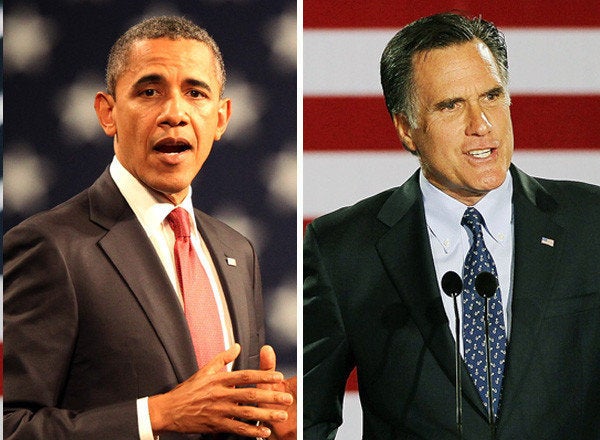
As I write this, President Obama and Governor Romney are preparing for their final pre-election debate in Boca Raton. Though Governor Romney has used climate change as joke material, it is no laughing matter in Florida, a place that has been called "ground zero when it comes to sea level rise." More than 120 city and county officials, scientists and concerned citizens are calling on the candidates to discuss their policies on this issue, so it's safe to assume that both candidates are rehearsing a response to the climate question.
Whatever answers they give will have to pass the 'brick wall' test.
Think of our CO2 emissions pathway as a superhighway, down which we are barrelling at breakneck speed. Up ahead is a brick wall spanning the highway. It's not a wall of climate impacts -- we are already experiencing those and more are unavoidable whatever we do. The wall is the point of no return, the moment when our emissions cross the threshold between dangerous climate change and globally catastrophic climate change.
Unfortunately, this brick wall is invisible. No one quite knows just how close we are to it. Or whether the signposts will tell us when we're nearly upon it. Or when we've hit the wall, how long it will take before we understand the full extent of our injuries. If this were a movie, right at the moment of impact the camera would switch to super slow-motion, and viewers would hold their breath in white-knuckled anticipation to see whether the hero survives or not. That is, assuming they hadn't hyperventilated from shouting "Brake you idiot, brake!"
Unfortunately this isn't a movie, and our elected leaders are blithely ignoring the world's climate scientists, most of whom are too polite to actually shout. But make no mistake, scientists are telling us to take our foot off the accelerator pedal and hit the brakes... fast.
The science and economics of climate change dictate that our CO2 emissions must peak (i.e. stop accelerating) and steeply decline (i.e. brake rapidly) well before the end of this decade. That's right -- in the next few years. If we don't manage to accomplish this feat, there's a good chance we'll hit the wall.
To give you a sense of how close we are to the wall, the following examples might make you want to fasten your seatbelts:
1) Upon release of the 2011 World Energy Outlook (PDF), the International Energy Agency said: "Without further action, by 2017 all CO2 emissions permitted in the 450 scenario will be 'locked in' by existing power plants, factories, buildings, etc." Just to be clear, the "450 scenario" would give us only a 50 percent chance of keeping global temperature rise below the 2° C danger threshold, and next to zero possibility of achieving the safer limit of 1.5° C.
2) According to ground-breaking research done by analysts at the Carbon Tracker initiative (PDF), for an 80 percent chance of limiting temperature rise to 2° C only 20 percent of the total proven fossil fuel reserves can be burned unabated, leaving the remaining 80 percent of reserves in the ground. At current rates of consumption, they estimate we will hit the 20 percent threshold in around 16 years.
In other words, in order to avoid hitting the wall -- whether it's expressed in terms of temperature rise, parts per million CO2 concentration in the atmosphere, or gigatons of emissions -- we can't afford to wait any longer.
By the way, if you think there's only a marginal difference between a 2° and 4° world (which are just off-ramps along the superhighway to a 6° world or higher) think again. Consider this quote from climate scientists Kevin Anderson and Alice Bows:
There is a widespread view that a 4 degrees C future is incompatible with an organised global community, is likely to be beyond "adaptation," is devastating to the majority of ecosystems, and has a high probability of not being stable (i.e., 4 degrees C would be an interim temperature on the way to a much higher equilibrium level).
The prospects are so frightening, yet so very real, that the World Bank is currently undertaking a serious analysis of the costs and risks in such a scenario, and I can guarantee that it won't make for happy reading.
So if the candidates do get asked the trillion-dollar question in Boca Raton, ask yourself whether their answers meet the brick wall test. If you hear them mention an 'all of the above' energy strategy? Smash. Drill Baby Drill? Crash and burn.
Even with a massive expansion of clean, renewable energy, we are not going to 'supply side' our way out of climate change. For a start, we need a comprehensive plan which involves large-scale conservation and dramatically improved energy efficiency, as well as a massive switch to renewables. At the same time, we must stop investing in new high-carbon energy sources and infrastructure. This isn't only about adding more renewables to the energy mix -- it's about displacing fossil fuels for which our current energy system is optimized.
This can be done. Just this summer Germany set a day record providing 50 percent of its electricity demand from solar. On one windy night in Spain this year, wind turbines provided more than 64 percent of the country's demand. Greenpeace spells out a scenario in the 2012 Energy Revolution plan (PDF) by which we could reach 90 percent renewables for both electricity and heating by 2050.
If you've ever seen what happens to crash test dummies when they hit the wall, just remember that the Earth didn't come equipped with airbags. Though it's unpleasant to watch, this video is a good reminder of just how impactful the next few years will be as the U.S. debates its energy future.
